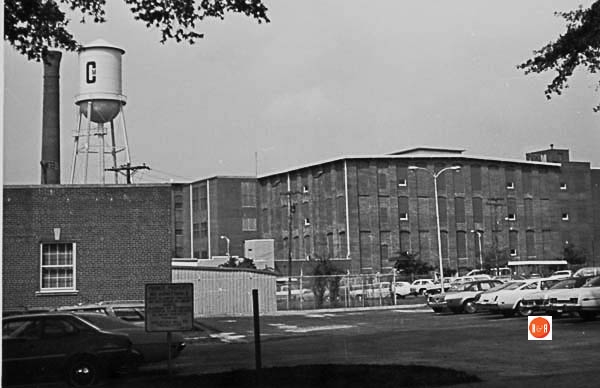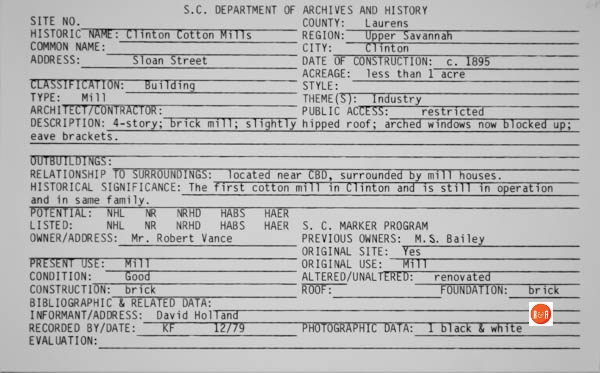City Directories and History: Many southern towns could boast of a cotton mill having been constructed in the town by 1900. Clinton was poised to bring several cotton mills to the upstate area just as Rock Hill, S.C. had done earlier and Greenville, S.C. had witnessed an explosive growth of mills.
The Rock Hill Herald reported on Oct. 14, 1896 – “Contractor W. G. Adams (of Rock Hill, S.C.) is working a force of hands on a portion of the cotton factory at Clinton.”
Industry has had a large part Clinton’s history beginning with the opening of the Clinton Cotton Mill in 1896. M.S. Bailey, founder of the local bank, opened the mill as a business venture. At three-stories, the brick mill building was the largest structure around, containing 5,000 spindles and 150 looms. Always the savvy entrepreneur, Bailey recruited sharecroppers from the Piedmont and Appalachian regions to work in the mill for one-half of the wages earned in the New England mills. In 1902, Bailey and his sons opened Lydia Mill and Clinton II in 1903. The mills offered approximately 800 homes to employees who lived, worked and shopped in the mill village.
Industry in Clinton was not limited to the cotton mills. The Clinton Oil Mill was located on what is now a vacant field at the intersection of Main Street and North Adair Street. The mill was a branch of the American Agricultural Chemical Company that manufactured fertilizer and cotton seed oil. There was also a large lumber yard and
lumber warehouse facility on Gary Street—where the Kentucky Fried Chicken parking lot is now located.
Industrial growth in the county reflected not only the economic success and growth of the town of Clinton, but also the success of its farmers, gin and seed oil mill operators, and merchants in the rural areas. The textile mills and the demand for uniforms and fabric during World War I fueled the continuing dominance of cotton agriculture. The guano and cotton warehouses that lined the railroad tracks in Clinton reflected the precarious life cotton farmers led, growing and constantly fertilizing their soil, hoping to make enough to pay off debts and to secure seed and supplies for the next season. Many gins and cottonseed oil mills remain on the rural landscape. Gins at Cross Hill and Mountville (Site 2072) represent a once thriving industry that offered a necessary service to local cotton farmers.
Eastern Laurens County Historical and Architectural Survey, SCDAH – 2003
Stay Connected
Explore history, houses, and stories across S.C. Your membership provides you with updates on regional topics, information on historic research, preservation, and monthly feature articles. But remember R&R wants to hear from you and assist in preserving your own family genealogy and memorabilia.
Visit the Southern Queries – Forum to receive assistance in answering questions, discuss genealogy, and enjoy exploring preservation topics with other members. Also listed are several history and genealogical researchers for hire.
User comments welcome — post at the bottom of this page.
Please enjoy this structure and all those listed in Roots and Recall. But remember each is private property. So view them from a distance or from a public area such as the sidewalk or public road.
Do you have information to share and preserve? Family, school, church, or other older photos and stories are welcome. Send them digitally through the “Share Your Story” link, so they too might be posted on Roots and Recall.
User comments always welcome - please post at the bottom of this page.









Share Your Comments & Feedback: